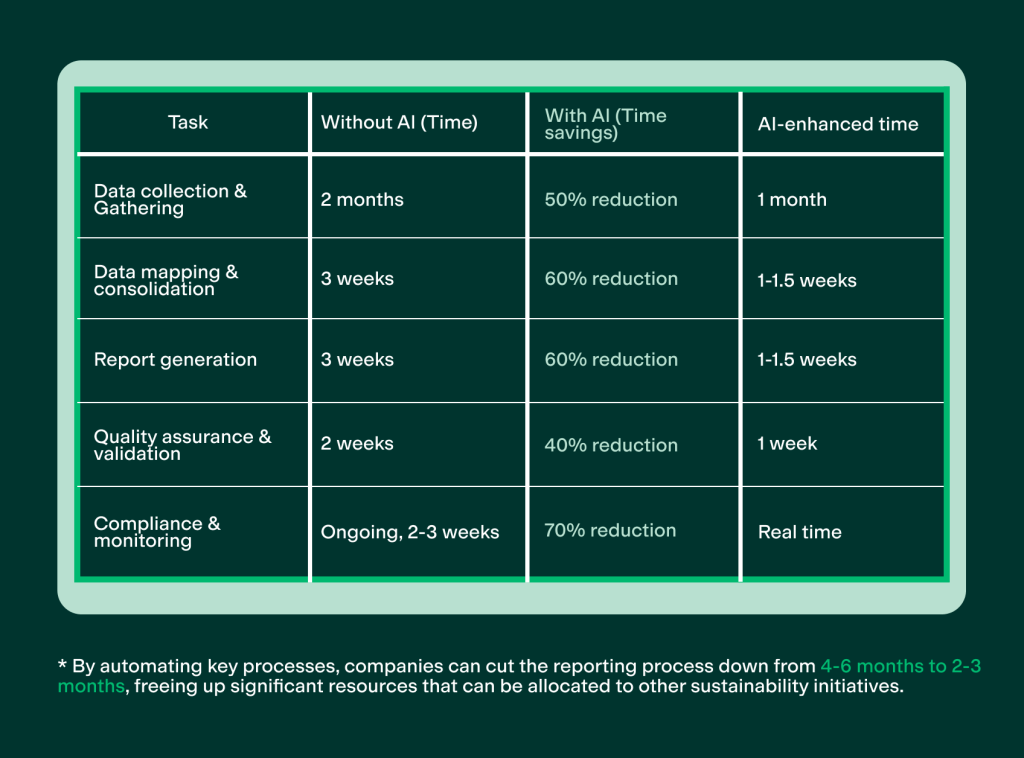How AI could cut ESRS reporting time by 50%
Clik here to view.

So, let’s explore how AI can streamline the ESRS reporting process, cutting the time spent on tasks by as much as 50%, while improving accuracy and deepening insight.
The challenge of ESRS reporting
The ESRS standards require companies to report on a broad range of sustainability metrics. These include both quantitative data (like energy consumption and emissions) and qualitative information (such as descriptions of governance practices and employee welfare policies). Gathering this information from various sources within the organization, mapping it to ESRS standards, and generating a comprehensive report can take several months—especially for large companies.
The typical ESRS reporting process includes the following stages:
- Data Collection: Gathering data from different departments and external sources.
- Data Mapping: Matching collected data to ESRS requirements.
- Report Generation: Structuring the information into a formal report.
- Quality Assurance: Ensuring that the data is accurate, consistent, and compliant.
- Compliance Monitoring: Staying updated with evolving regulations and ensuring ongoing compliance.
Without AI, these stages can involve extensive manual effort, often requiring specialized teams to spend months on data collection, validation, and report writing.
How AI streamlines ESRS reporting
AI technologies – especially large language models (LLMs) – are revolutionizing sustainability reporting by automating time-consuming tasks and improving data accuracy. Here’s how AI enhances each stage of the ESRS reporting process:
1. Automated data collection
Traditional ESRS reporting systems require teams to manually gather data from a variety of departments and systems. This often involves chasing down stakeholders, manually retrieving data from disparate sources, and ensuring it’s up to date.
With AI: AI tools can automate the retrieval of data from internal systems, external databases, and even unstructured documents. By using machine learning (ML) models to extract relevant data from emails, reports, and other formats, companies can save 50% of the time spent on data collection.
2. Data mapping & policy interpretation
ESRS reporting requires mapping the gathered data to specific standards, which often involves interpreting internal policies and ensuring they align with ESRS requirements.
With AI: LLMs can auto-map internal policy documents to ESRS standards. NLP algorithms can interpret the text in policies, flag relevant sections, and answer questions directly—whether they are Yes/No, narrative, or numeric. This reduces the time spent on mapping and interpreting policies by 60%.
3. Report generation with AI
Generating a sustainability report that covers all ESRS requirements is another labor-intensive step. Companies often spend weeks writing, revising, and ensuring the report meets both internal and external expectations.
With AI: LLMs can generate the first draft of the report based on the gathered data, reducing the need for multiple iterations. These models can summarize information, provide consistency across narratives, and ensure compliance. Companies can see up to 70% savings in report generation time, as human involvement is reduced to final edits and reviews.
4. Quality assurance & data validation
One of the most critical steps is ensuring that the data presented in the report is accurate, consistent, and compliant with ESRS standards. Without AI, this step often involves multiple layers of manual review and data cross-checking.
With AI: Machine learning models can automatically validate data, ensuring that numerical data aligns with narrative statements and flagging any inconsistencies. AI models can also identify gaps in the data and provide suggestions for missing information, saving up to 50% of the time spent on quality assurance.
5. Real-time compliance monitoring
ESRS standards are likely to evolve over time, and companies must ensure that they remain compliant with new regulations. Without AI, this requires frequent manual reviews and updates to reporting frameworks.
With AI: AI tools can monitor regulatory changes in real time, alerting companies to updates and suggesting necessary changes to their reports. This continuous monitoring reduces the manual effort involved by as much as 70%.
The time savings: A realistic estimate
Based on industry estimates and the experiences of companies already leveraging AI in sustainability reporting, the use of AI can reducle the overall time spent on ESRS reporting by 30-50%. Here’s a breakdown of the time savings for each stage of the process:
Clik here to view.

Beyond time savings: Enhanced accuracy and insight
While the time savings are substantial, it’s worth noting that AI also offers other benefits in ESRS reporting:
- Increased Accuracy: AI models reduce the risk of human error, ensuring greater accuracy in both data and narrative reporting.
- Enhanced Insights: AI can provide real-time insights into sustainability data, allowing companies to make informed decisions that go beyond compliance and drive real sustainability outcomes.
- Consistency Across Reports: LLMs ensure that sustainability reports maintain a consistent tone, style, and structure, regardless of the number of contributors or data sources involved.
Conclusion: The future of ESRS reporting with AI
AI offers a powerful solution to streamline the process, improve accuracy, and reduce time spent on compliance. By automating tasks like data collection, mapping, report generation, and validation, companies can save as much as 50% of the time spent on ESRS reporting, allowing them to focus more on driving meaningful sustainability efforts.
And at Position Green, we know that the future of sustainability reporting lies in the intelligent use of technology, with AI at the forefront.
Not only is it part of our core roadmap to create an even better experience for you in our Sustainability Suite, it’s already in use via our AI Analyst.
This feature allows you to:
- Cut down on manual analysis and get data-driven knowledge on your sustainability performance, allowing you to get a sharper overview of your progress.
- Answer stakeholder queries quickly and share insights faster internally, helping bring your entire business along for the ride, leveraging your sustainable insights for greater corporate impact.
…And we’re only getting started with AI.
If you’re interested in learning more about our AI roadmap, and getting access to a ESG management software that is built to automate compliance now and into the future, get in touch with us!
Get your introductionClik here to view.

Victor Friberg
AI Lead
Position Green
Stay up to date with the latest ESG-trends.
The post How AI could cut ESRS reporting time by 50% appeared first on Position Green.